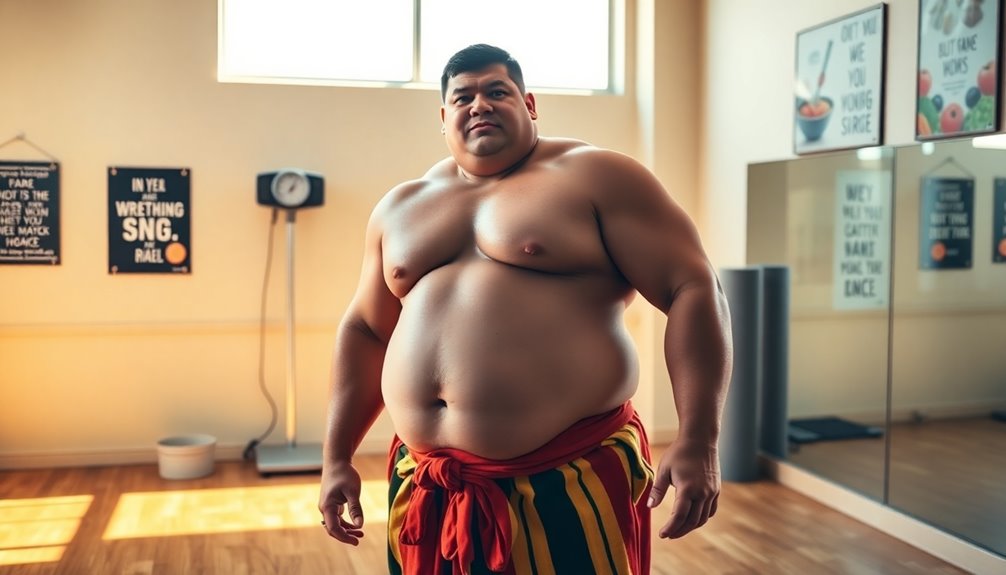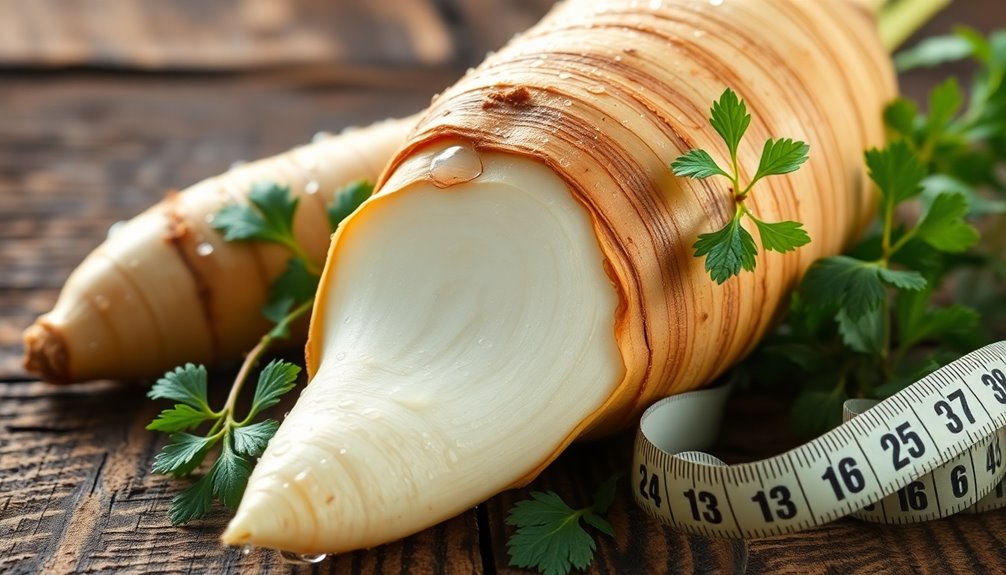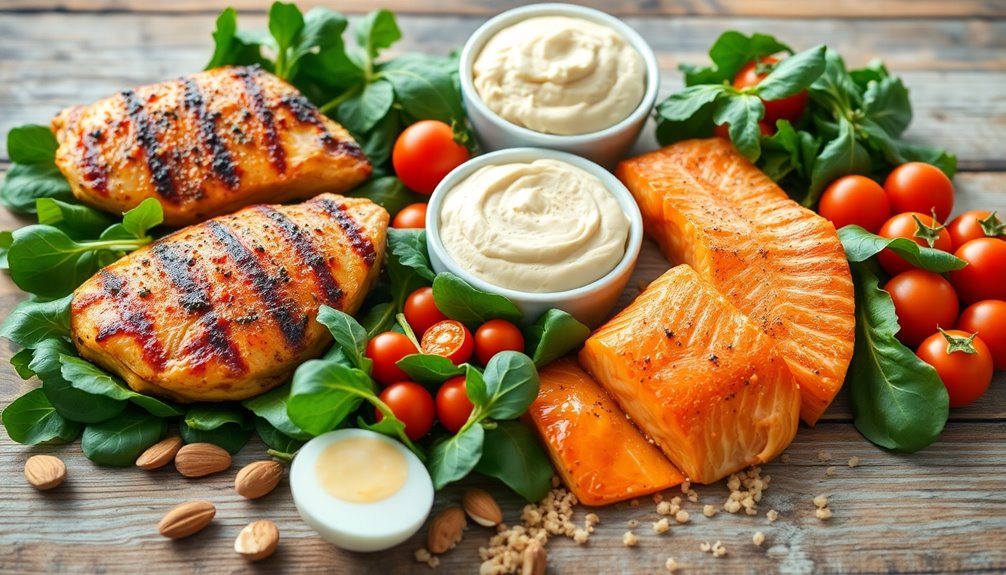Emanuel Yarbrough's journey from a 600-pound sumo wrestler to a healthier lifestyle is truly inspiring. You'll see how he faced significant health risks due to obesity, including diabetes and heart disease. His rigorous training regimen shaped his life from a young age, but even after retirement, he faced challenges in maintaining his health. By embracing better nutrition and staying active, he showcases determination and resilience. This transformation not only highlights the importance of weight management but also celebrates the cultural significance of sumo wrestling. Discover how his story can motivate you on your own path to health!
Key Takeaways
- Emanuel Yarbrough's weight loss journey from 752 to 550 pounds illustrates determination in reclaiming health and improving mobility.
- Competitive events like U.S. Olympic judo showcase the commitment required for a successful health transformation.
- Sumo wrestlers face high risks for chronic diseases, emphasizing the importance of weight management for long-term health.
- Nutritional awareness, including balanced meals and reducing processed foods, is crucial in preventing obesity and related health issues.
- The cultural significance of sumo wrestling reinforces community support, motivating wrestlers in their health journeys through shared heritage and pride.
Emanuel Yarbrough's Weight Loss Journey
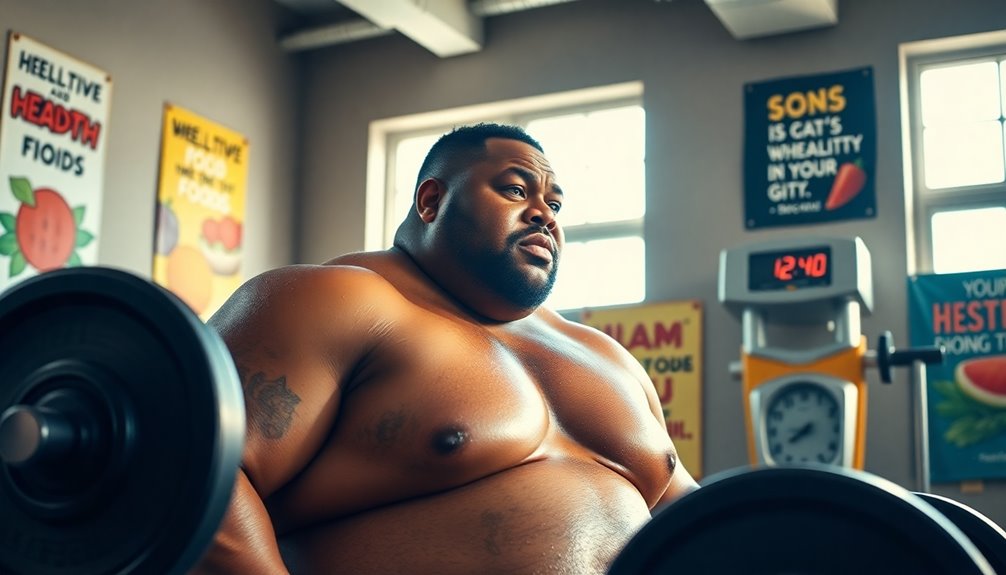
Emanuel Yarbrough's weight loss journey is nothing short of inspiring. As a former sumo wrestler champion, he's tackling an incredible challenge—losing over 200 pounds, aiming to go from 752 pounds to a healthier 550.
You can see his determination as he undergoes this transformation under medical supervision, ensuring safety and effectiveness every step of the way.
Yarbrough's commitment to his sport remains strong. He's not just focusing on weight loss; he's actively participating in competitive events like the U.S. Olympic judo qualifying match and the Sumo World Championships.
This dedication showcases his belief that being a sumo wrestler doesn't have to mean sacrificing health for the sake of performance.
He's acknowledged the significant health risks that come with excessive weight gain, and this motivates him to change.
By shedding those pounds, Yarbrough isn't just focusing on aesthetics; he's aiming to improve his overall health, mobility, and athletic performance.
Watching him on this journey, you can't help but feel inspired by his resolve and unwavering spirit in the face of adversity, proving that change is possible, even for sumo wrestlers.
Health Risks of Obesity
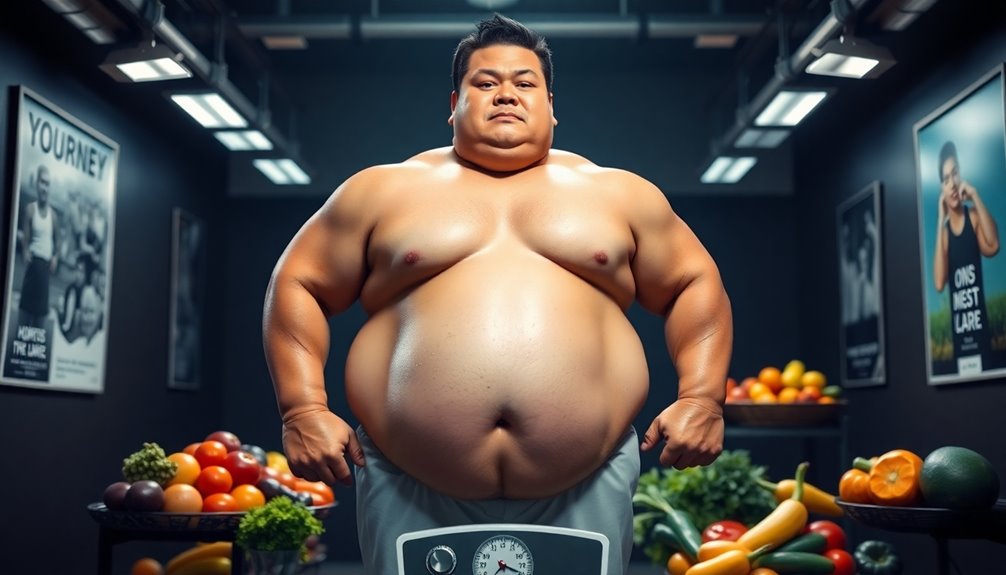
Obesity poses significant health risks that can drastically affect your quality of life. You may find yourself at a higher risk for serious conditions such as type 2 diabetes, heart disease, and certain cancers, which can lead to increased morbidity and mortality. Individuals with obesity may also experience permanent hearing loss due to the associated health complications. Additionally, studies suggest that aromatherapy can promote relaxation, which may help mitigate stress-related behaviors that contribute to weight gain. Furthermore, obesity can exacerbate symptoms of brain fog, making it more challenging to maintain focus and clarity. Incorporating a low carb high protein breakfast can be a beneficial strategy for those looking to manage their weight effectively.
With obesity, mobility can become reduced, and joint issues often arise, complicating your overall health.
Studies show that sumo wrestlers, despite their impressive physical strength, face heightened health risks due to their weight, resulting in a life expectancy approximately 10 years shorter than the average population. This stark reality highlights the importance of addressing obesity.
If you're looking for change, significant weight loss—often exceeding 5-10% of your body weight—can lead to remarkable improvements in blood pressure, cholesterol levels, and blood sugar control. Additionally, incorporating anti-inflammatory herbs like turmeric's curcumin into your diet may help manage joint inflammation and improve overall health.
Achieving sustainable weight management requires lifestyle changes, including a balanced diet and regular physical activity.
The Sumo Wrestling Lifestyle
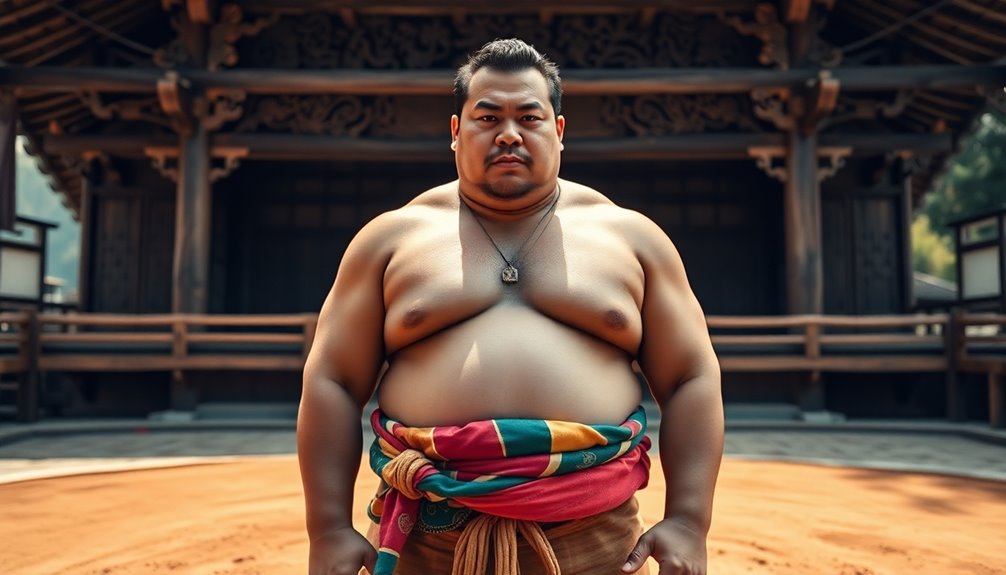
In the world of sumo wrestling, you're looking at a lifestyle defined by rigorous training routines and unique dietary habits. As you explore how these elements shape a wrestler's life, you'll uncover the health risks that come with such an intense regimen. Understanding this balance is key to grasping the incredible journey to health that sumo wrestlers navigate. Additionally, the importance of proper insulation in maintaining a conducive training environment cannot be overlooked, as it helps wrestlers focus on their performance without distraction from external elements.
Rigorous Training Routines
Stepping into the world of sumo wrestling reveals a lifestyle defined by rigorous training routines that start as early as age 15 or 16 in strict academies.
You'll find that each day is packed with intense physical activity aimed at building strength and gaining weight. Heavy lifting, practice bouts, and flexibility exercises form the backbone of your routine, all designed to enhance your performance in the ring.
Training isn't just about pushing weights; it's a holistic approach geared toward developing a sumo wrestler's unique physique.
You'll often skip breakfast, saving room for large lunches that fuel your demanding schedule. Napping becomes an essential part of your day, allowing your body to recover and recharge for the next round of grueling exercises.
While the focus is on rigorous workouts, there's also a social aspect to your training. Wrestlers engage in significant alcohol consumption during midday, adding another layer to the lifestyle.
This combination of intense training, rest, and social interaction shapes not just your physical form but also your identity within the sumo community. Embracing this lifestyle is vital for anyone serious about making it in the ring.
Dietary Habits Explained
Nutrition plays an essential role in the sumo wrestling lifestyle, where wrestlers embrace a diet designed to support their rigorous training and weight gain goals. Their meals are typically calorie-dense, with chanko nabe—a hearty stew of meat, fish, and vegetables—being a staple. Curiously, many sumo wrestlers skip breakfast, opting for large lunches that can exceed 5,000 calories, often accompanied by significant alcohol consumption, especially beer. This high-calorie intake can lead to long-term health issues if not balanced properly, and it is crucial to recognize the importance of hydration to support overall health. Engaging in low-impact exercises can help mitigate some of the health risks associated with their lifestyle. Additionally, proper nutrition can prevent acute kidney failure, which is a serious concern for pets, illustrating the importance of understanding dietary impacts on health.
To help you visualize typical meal components, here's a summary:
| Meal Type | Common Foods | Purpose |
|---|---|---|
| Breakfast | Skipped | N/A |
| Lunch | Chanko nabe, beer | Fuel for training, weight gain |
| Dinner | Rice, protein, veggies | Recovery, muscle building |
| Snacks | Fruit, nuts | Additional calories |
| Hydration | Water, beer | Replenishment |
Their high-calorie diet works in tandem with rigorous training routines, including rest periods for napping. However, this lifestyle can contribute to obesity and related health issues, impacting their overall life expectancy. Additionally, maintaining a balanced diet is crucial to avoid potential financial mistakes that can arise from poor health management later in life.
Health Risks Overview
The lifestyle of sumo wrestling, marked by a unique blend of intense physical training and calorie-dense diets, poses significant health risks for its practitioners. As you immerse yourself in this world, it's essential to recognize the potential dangers that come with it.
Sumo wrestlers often experience a drastically reduced life expectancy—about ten years less than the average Japanese citizen—due to health complications linked to their weight and lifestyle.
Here are some of the most pressing health risks:
- Obesity-related issues: The high-calorie meals, like chanko nabe, can lead to severe obesity, increasing the risk of diabetes. Maintaining a balanced diet is crucial for overall health and can help mitigate these risks. Furthermore, implementing a retirement savings plan could support wrestlers in managing their finances post-career, allowing for healthier lifestyle choices.
- Cardiovascular diseases: Many wrestlers grapple with heart conditions stemming from their excessive weight.
- Joint problems: The physical strain from training and matches often results in chronic joint pain and mobility issues.
- Long-term health complications: After retiring, wrestlers face significant risks due to poor dietary habits and inactivity during their career.
Growing awareness of these risks is prompting discussions about necessary lifestyle changes to promote better health among current and former wrestlers. Additionally, the principles of emotional alignment can play a crucial role in helping wrestlers transition to healthier post-career lifestyles.
Challenges After Retirement
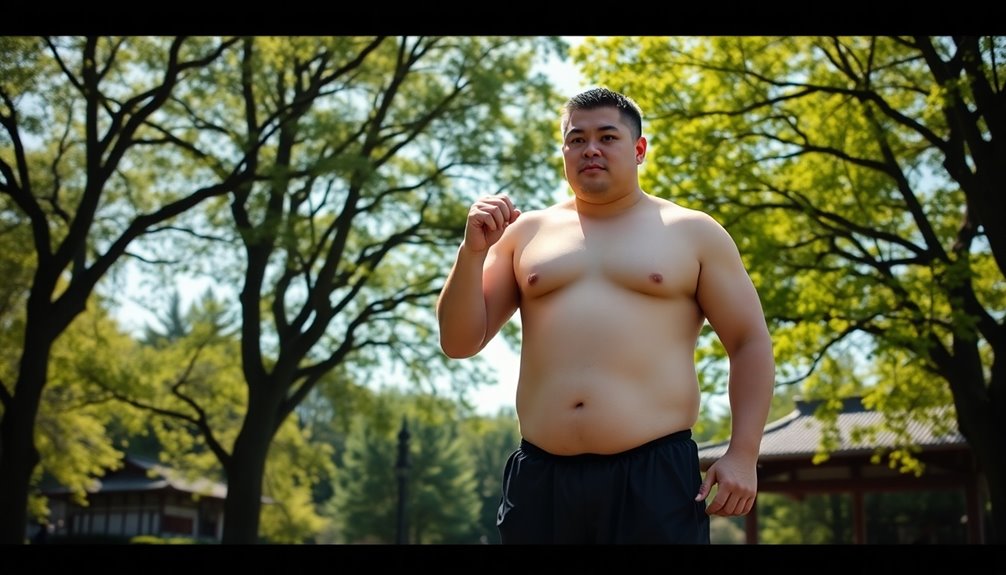
Many retired sumo wrestlers encounter significant challenges that can impact their overall well-being. After leaving the ring, you might face serious health issues stemming from your previous weight and lifestyle choices. Conditions like diabetes and heart disease are common, making weight management essential for your post-career life. Additionally, managing chronic pain related to past injuries can further complicate your health journey. Incorporating herbal alternatives such as hibiscus may also help improve skin elasticity and hydration, which is beneficial for overall health. Furthermore, understanding the importance of long-term financial planning can alleviate stress related to medical expenses and ensure a stable future.
Unfortunately, these health problems can lead to a shorter life expectancy compared to the average population.
Transitioning to a new career can be particularly intimidating for you. Many former wrestlers have limited education, which complicates finding satisfying employment opportunities outside the sport. While some manage to pivot into business ventures related to their sumo experience, this success isn't the norm for everyone. You may find it hard to navigate the job market, especially if you lack transferable skills.
Moreover, the sense of camaraderie and identity built during your sumo career can be hard to replicate in civilian life. These emotional challenges, combined with physical health concerns, require a strong support system. Understanding the importance of self-care during the transition can significantly aid in coping with these challenges.
Addressing these issues early on can help you forge a healthier, more fulfilling path after retirement.
Cultural Significance of Sumo
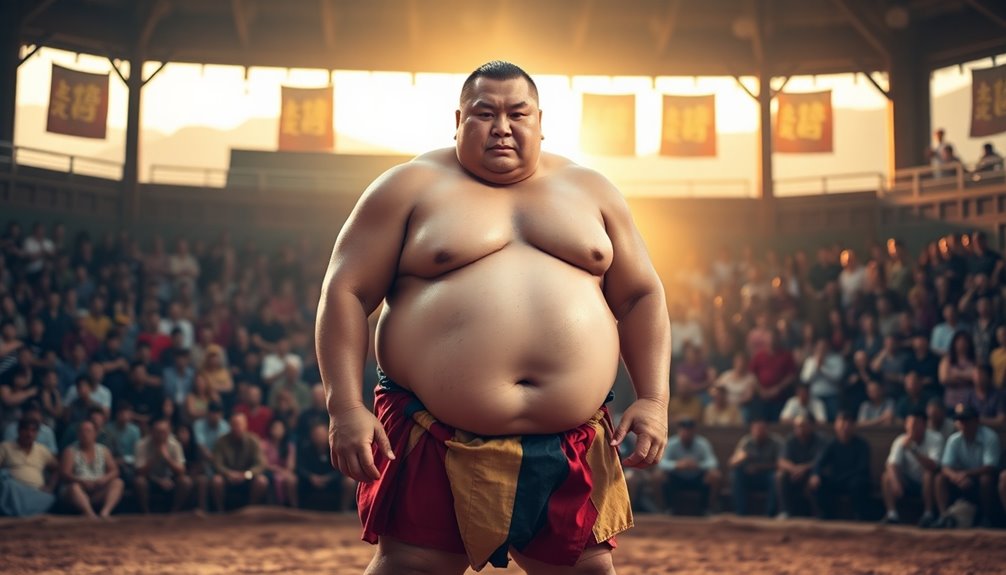
Rooted in centuries of tradition, sumo wrestling stands as a powerful symbol of Japanese culture. With origins tracing back over 1,500 years, it's one of the oldest organized sports in the world.
Sumo isn't just a physical competition; it's a rich tapestry woven with rituals and ceremonies. For you, experiencing sumo means witnessing:
- Shinto purification rites, performed before each match, connecting wrestlers to spiritual beliefs.
- Grand tournaments, where thousands gather, filling arenas with excitement and reverence for the athletes.
- Celebrated wrestlers, akin to modern-day celebrities, enjoying immense media attention and fanfare, becoming icons of strength and perseverance.
- Cultural practices, reflecting a lifestyle that includes disciplined training and specific customs that honor Japan's heritage.
As you explore the world of sumo, you'll see how it contributes to local economies, drawing tourists and creating community pride.
The sport's significance transcends its physicality, embodying values of respect, tradition, and dedication. By engaging with sumo, you're not just watching a sport; you're partaking in a cultural phenomenon that has stood the test of time.
Nutrition and Diet Choices
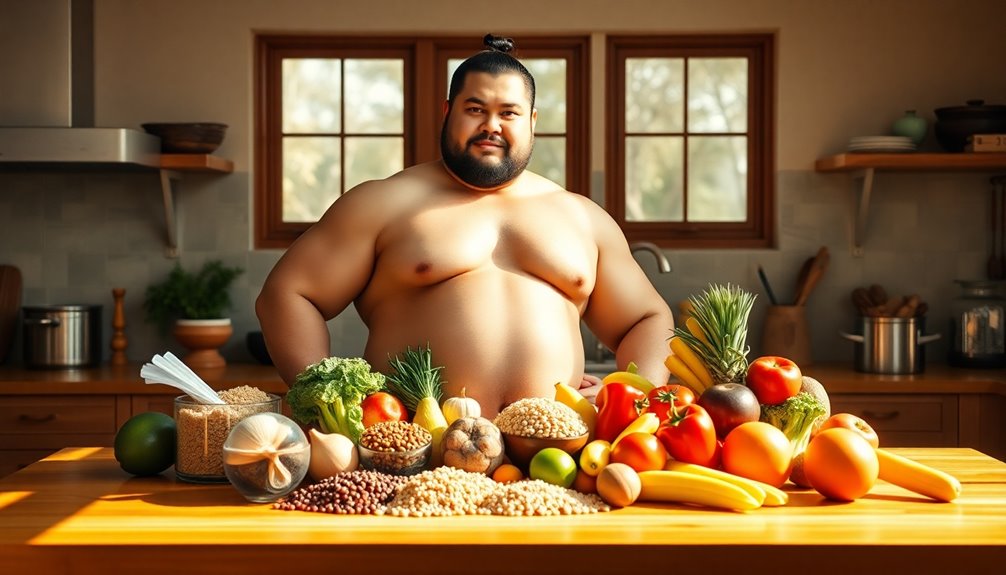
When it comes to nutrition and diet choices in sumo, you'll find that traditional meals like chanko nabe are designed for weight gain and energy. However, unhealthy eating patterns, like skipping breakfast and excessive alcohol consumption, can undermine your health. Regularly incorporating chia seeds into your diet can offer a variety of health benefits, including improved digestion and heart health. Chia seeds are also a rich source of dietary fiber, which is essential for maintaining digestive health, and they provide high omega-3 content, which is beneficial for heart health. Additionally, including glycolic acid in your skincare routine can enhance hydration and improve skin texture, which is important for overall health and wellness.
Exploring healthier eating strategies is essential for balancing cultural practices with overall well-being. Incorporating low carb foods can help sumo wrestlers maintain energy levels while promoting better health outcomes.
Traditional Sumo Diet
The traditional sumo diet is designed to fuel the intense physical demands of wrestlers, focusing on calorie-dense foods to support their weight gain and muscle development. Wrestlers typically skip breakfast, opting instead for a substantial lunch that serves as their primary meal of the day. This meal often exceeds 2,000 calories, providing the energy needed for their rigorous training.
Here are some key components of the traditional sumo diet:
- Chanko Nabe: This hearty stew, filled with meat, vegetables, and tofu, is a staple for wrestlers, packed with nutrients and calories.
- Large Portions: Wrestlers consume massive quantities of food in one sitting, often leading to an overabundance of calories.
- Midday Naps: After lunch, a nap aids digestion and energy recovery, allowing wrestlers to recharge for training.
- Alcohol: Beer is commonly consumed during meals, contributing extra calories and aiding weight gain.
While this diet supports their training, it also poses risks. Poor dietary habits can lead to obesity and health issues, emphasizing the importance of nutritional awareness in the sumo world. Additionally, understanding chronic wounds can be crucial for wrestlers who may face injuries during their intense training.
Healthy Eating Strategies
Healthy eating strategies can transform your approach to nutrition and enhance overall well-being. As you shift your focus from traditional calorie-dense meals to healthier options, consider incorporating more nutrient-rich foods into your diet.
While chanko nabe offers essential proteins and carbohydrates, balance it with an array of fruits, vegetables, and whole grains to boost your nutritional intake.
It's important to be mindful of portion sizes to manage your caloric intake effectively. Instead of relying on processed foods and alcohol, which can lead to obesity, prioritize whole foods that support your health goals.
Meal planning can help you avoid unhealthy choices and guarantee you're consuming balanced meals.
Awareness of the long-term health risks associated with obesity is critical. By adopting these healthier eating strategies, you'll not only work towards sustainable weight management but also improve your overall quality of life.
Embrace this journey by making small, consistent changes to your diet, and you'll find that your body and mind will thank you. Remember, it's all about creating a lifestyle that supports your health and well-being for the long haul.
The Role of Training
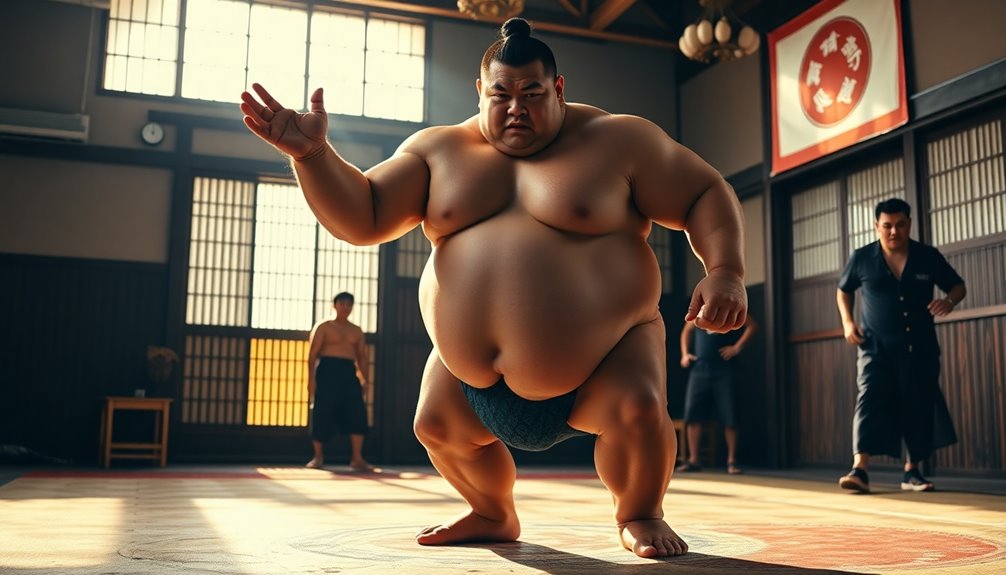
Training plays an essential role in the journey to health for sumo wrestlers, shaping both their physical capabilities and overall well-being. Starting their training at ages 15 or 16, wrestlers adhere to strict regimens designed to boost strength and agility. Their daily routine is rigorous, emphasizing weight gain and recovery.
Here are four key components of their training:
- Chanko Nabe Meals: Wrestlers consume large quantities of this nourishing stew, packed with protein and calories, to fuel their bodies.
- Rigorous Workouts: They engage in intense physical training sessions, focusing on techniques that improve their combat skills and overall fitness.
- Scheduled Naps: These essential rest periods help wrestlers recover and maintain energy levels throughout their demanding days.
- Weight Management: While excess weight is common, training also emphasizes finding a balance to enhance performance and longevity in the sport.
This structured approach not only prepares wrestlers for competition but also aims to address the long-term health challenges they face due to their unique lifestyle.
Through dedicated training, they work towards improving both their physical prowess and overall health.
Inspiring Transformation Stories
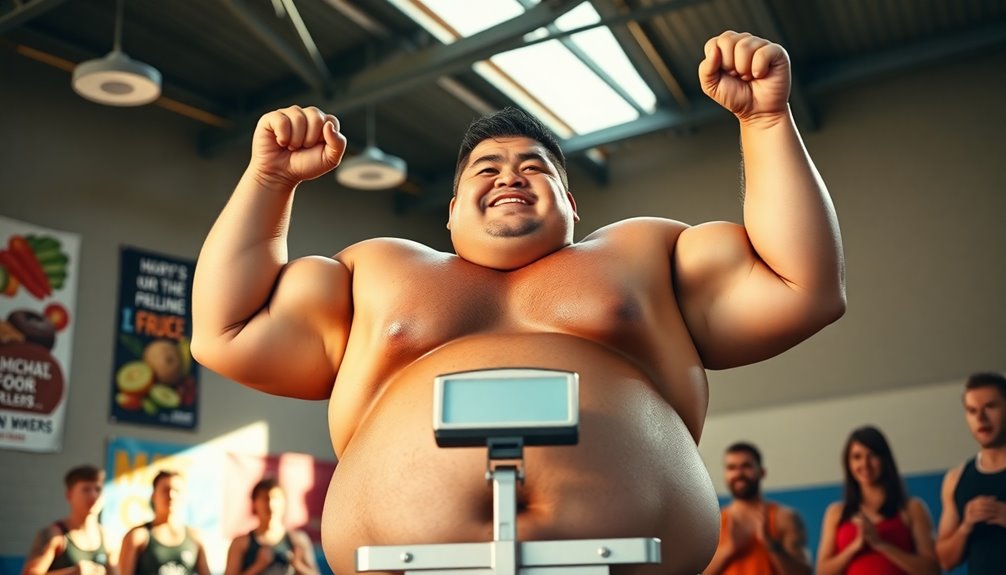
Sumo wrestlers often face unique challenges when it comes to their health, but inspiring stories of transformation show that change is possible. Take Emanuel Yarbrough, for example. This former sumo wrestling champion is on a remarkable weight loss journey, aiming to shed over 200 pounds.
Currently weighing 752 pounds, he's targeting a healthier weight of 550 pounds. His progress is closely monitored by medical professionals, emphasizing the importance of health supervision during significant weight management.
Yarbrough's dedication is evident through his participation in competitive events like the U.S. Olympic judo qualifying match and the Sumo World Championships. These endeavors aren't just about competition; they're about reclaiming his health and enhancing his mobility.
By addressing the health risks associated with obesity, Yarbrough's journey illustrates how sustainable lifestyle changes can profoundly impact athletic performance and overall quality of life.
His story inspires others in similar situations, proving that with determination and the right support, transformation is achievable.
Frequently Asked Questions
Who Is Considered the Greatest Sumo Wrestler of All Time?
When you think about the greatest sumo wrestler of all time, Taiho Kōki often comes to mind, thanks to his impressive 32 tournament championships.
However, Hakuhō Shō has also made a strong case by surpassing that record with 45 championships and 63 consecutive wins.
Chiyonofuji Mitsugu, known for his technique and longevity, is another name worth mentioning.
Each of these wrestlers has profoundly shaped the sport's legacy and popularity in Japan and beyond.
Why Do Sumo Wrestlers Not Gain Belly Fat?
You might think sumo wrestlers are just living large on a diet of donuts and couch potatoes, but that's far from the truth!
They're actually engaging in intense training that builds muscle rather than fat. While their meals are calorie-rich, they're designed for strength and recovery.
Plus, with regular napping, they keep their bodies in prime condition. So, despite their size, they don't accumulate belly fat like you'd expect!
What's the Average Lifespan of a Sumo Wrestler?
The average lifespan of a sumo wrestler is about 10 years less than that of the average Japanese citizen, which is around 73 years.
This reduced lifespan's often due to obesity and related health issues, like high blood pressure, diabetes, and heart disease.
You should also consider that many retired wrestlers face ongoing health problems, stemming from their previous lifestyle and intense training regimens, further impacting their longevity.
Do Sumo Wrestlers Slim Down When They Retire?
You might be surprised to learn that many sumo wrestlers do slim down after retirement.
As they shift away from calorie-heavy diets and intense training focused on weight gain, they often adopt healthier eating habits and more active lifestyles.
This change can lead to impressive weight loss, sometimes hundreds of pounds over a few years.
However, the journey isn't always easy, as old habits can persist, posing challenges in maintaining their new, healthier weight.
Conclusion
Emanuel Yarbrough's incredible journey shows that transformation is possible, no matter the weight on your shoulders. His story is a demonstration of resilience, proving that even in the ring of life, we can rise above. The challenges he faced became stepping stones, leading him to a healthier path. Just like a sumo wrestler learning to balance, you too can find your footing and embrace change. Remember, every journey begins with a single step—take yours today!
